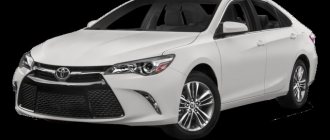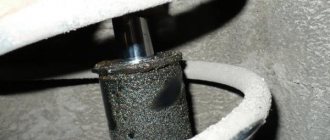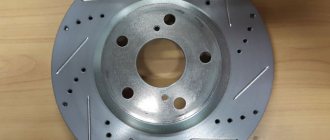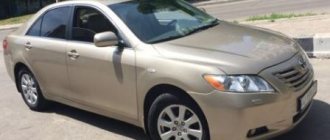Toyota Camry is the best-selling sedan in its segment. Compared to its predecessor, the new model has received a complete redesign. Every piece of sheet metal, every platform element, suspension and every internal component is different. Only some engines and gearboxes are carried over from the V40.
The Japanese sedan has never been a trendsetter. The new design of the Toyota Camry definitely skews towards pragmatism. Sharp edges and sharp corners are the result of the struggle to improve aerodynamics.
The undeniable strengths of the Camry are comfort, roominess, reliability, price/quality ratio and resale value. For the most part, the V50 has maintained parity. It has become much more pleasant to drive, thanks to optimized handling and good equipment. Thanks to the more powerful 4-cylinder engine, the dynamics have also increased. The Camry drives better than ever, and the top-of-the-line V6 will satisfy the needs of those who want a fast but relatively inexpensive sedan.
Toyota Camry also holds its own in terms of safety. Standard equipment includes driver and passenger airbags, side and window airbags (curtains) for front and rear passengers. Despite the slight loss in weight, the body has become even stronger. In 2012, the sedan received the highest safety mark “Top Safety Pick” based on the results of American NHTSA crash tests.
From the history of the model
ON THE CONVEYOR:
from 2011 to 2021
BODY:
sedan
RUSSIAN RANGE OF ENGINES:
petrol, P4, 2.0 l (148 and 150 hp);
2.5 l (181 hp); V6, 3.5 l (277 and 249 hp) GEARBOXES:
A4, A6
DRIVE:
front
RESTYLING:
2014 - update of head lighting equipment, lights, radiator grille, hood, trunk lid, front and rear bumpers;
the center console, steering wheel and instrument panel have been refreshed; new design and materials of some interior trim elements; the range of engines and gearboxes has been revised: the four-speed automatic has been eliminated, instead of the 2.0 1AZ series engine (148 hp), a more recent 2.0 6AR engine (150 hp) has appeared. CRASH TESTS:
2012, ANCAP;
overall score - (36.59 out of 37 points): frontal impact - 15.59 out of 16 points, side impact - 16 out of 16 points
General information about the Toyota Camry 50
The first car of this series was released in 1980 and it was called Celica Camry. It was a 4-door sedan developed on a coupe platform. At the time of release, the model received a new design. It was equipped with power steering, electric windows and mirrors.
The power of the first Camry was 95 hp. s., engine capacity - 1790 cc. see. The machine turned out to be too bulky and did not receive recognition from buyers.
Subsequently, the model was repeatedly improved and refined. Since 2011, the seventh generation Toyota Camry V50 has been produced. It appeared on the Russian market in 2012. At first, the car was imported from Japan, but now it is produced in the Leningrad region.
BODY
1.
The most obvious of the body problems is
corrosion on the hood and trunk lid (applies only to “pre-reform” cars)
.
On this occasion, the manufacturer issued a technical bulletin describing the repair procedure. Guided by it, dealers managed to repaint many cars during the warranty period. Under the chrome trim on the hood and trunk lid, electrochemical corrosion occurs at the points of their attachment (bolt connection), which spreads to the body panels. Repair according to the technical bulletin involves repainting the affected parts using an acid primer. Repeated electrochemical corrosion is excluded by insulating the fasteners of the linings (heat-shrinkable tubes) from the body panels (polyethylene patches in the holes). Also, on pre-restyling cars, the quality of the hood anti-corrosion protection is very poor. A small chip is enough for the paint to swell. All of these shortcomings were corrected when the car was updated.
ENGINES
1. In-line petrol “four” 2.0 series 1AZ
Only available on pre-restyling cars. This unit is a representative of the old guard, one of the most reliable and unpretentious among its classmates. The list of its mild illnesses is limited to some weaknesses common to all Camry engines: leaking crankshaft seals, fragility of the cooling system pump, noise of phase shifters. Moreover, the rumble of the phase shifters during the first 10 seconds after starting a cold engine appears over time, stops progressing and does not indicate significant wear of the components. According to the service technicians, you can safely drive on with such a noise effect if you don’t mind spending money on a new clutch.
2.
The more recent
2.0 engine of the 6AR family
is installed on restyled Camrys. It is devoid of mechanical problems; all its troubles come from the use of direct injection. Like many similar engines from other manufacturers, the 6AR is extremely sensitive to fuel quality. The situation is aggravated by the approval of “ninety-second” gasoline. Many owners perceive this as permission to refuel anywhere, so errors constantly appear, signaling a lean air-fuel mixture due to clogged injectors. In addition, on engines with this type of injection, deposits on the intake valves grow more actively.
The Japanese were able to cure a common disease of Camry engines - leaking crankshaft seals - in the last years of car production: weakness of the rear cuff - in 2021, and the front - a year later. This applies to the 2.0 6AR and 2.5 2AR engines. On these units, the noise of the drive belt tensioner was also eliminated - the manufacturer released a modified unit.
3.
The lion's share of cars sold is equipped with
a 2.5 2AR series engine
. He does not suffer from serious illnesses; unlike the 2.0 6AR unit from the same family, it has conventional distributed injection and, therefore, is quite unpretentious.
However, it is on the 2AR that the phase shifters make the most noise (among other Camry engines). And therefore, on this engine, dealers quite often had to change the coupling on the intake camshaft.
Also, on a 2.5 engine, the generator overrunning clutch often jams. During repairs, it is replaced with a modified one.
Dealers do not always replace a leaking cooling system pump (applies to all Camry engines). The manufacturer has issued a bulletin with criteria for evaluating the malfunction. The pump cannot be replaced if traces of leakage are caused by the release of a small volume of antifreeze when the pressure is exceeded through the drain hole on its body. But if the fluid is actively leaking from other places, then replacement is prescribed.
4. Engine 3.5 V6 2GR series
- another over-aged unit.
It has a good reputation and is well known from the previous generation Camry and many other Toyota models. It doesn’t have any serious shortcomings, but there are some childhood illnesses that are common to the rest of the engines on our list, and one rare, but very unpleasant surprise.
Initially, the engine had a power of 277 hp, but in 2013 it was derated with the help of appropriate firmware to a tax-efficient 249 hp. So, on “pre-reform” Camrys there were cases when a faulty timing chain tensioner was hidden under the apparent knock of the phase shifters. The modernized unit began to be installed on the conveyor in September 2013.
The most serious malfunction is foreshadowed by a knock in the fifth cylinder. For unknown reasons, it is rarely found on Camry and much more often, for example, on the Lexus GS 300 and Highlander with this engine. Due to engine overheating, it is in the fifth cylinder that scuffing occurs, leading to knocking and increased oil consumption. Considering that such Camrys are very often driven to their tails and manes, when inspecting a used car, pay special attention to engine diagnostics. Without a king in your head, you can kill even such a generally successful unit.
GEARBOXES
1. Six-speed automatic transmissions Aisin U660 and U760 series
belong to the same family with a common design base. The older U660 gearbox appeared a little earlier and is paired with six-cylinder engines. The U760 automatic is its later modification, assigned to engines of smaller capacity and with more modest torque. In general, the units do not have weak points in the mechanical part, but there are nuances.
The U660 machine breaks down mainly due to inadequate operation. It is paired with a 3.5 engine. Many owners of such cars are too keen on city racing and do not keep their radiators clean. Under such conditions, the box overheats greatly and can die within 50,000 km. In this case, the first thing that suffers is the valve body (body deformation), which is initially sensitive to overheating (a feature of many Aisin models), and this is followed by more serious damage.
SUSPENSION
1. All suspension elements, with rare exceptions, have a very long service life.
By today's standards, it can safely be called very tenacious, almost eternal.
2. Problems with electric power steering
(components built into the steering column)
not marked
. A conventional mechanical rack does not cause any trouble.
3.
A feature of many Toyota models is
the rapid souring of the rear caliper guides
. They begin to rattle if the owner does not regularly service the brakes.
4.
Several years ago, one of the widespread problems was too
rapid wear of the rear stabilizer bushings
. Often they died already at 30,000 km. Depending on the year of production, either the bushings were replaced separately or the stabilizer assembly was replaced on the car. The replaced rubber bands no longer suffered from premature aging.
5.
For “pre-reform” cars produced from March 2011 to August 2014, there is
a recall campaign
.
This involves inspecting the ball joint boots
, which may have been damaged when installed in the knuckles at the factory. Usually they were limited to only visual inspection; only in isolated cases did the ball bearings (available as separate spare parts) have to be replaced due to damaged boots.
Chassis
Front suspension with MacPherson shock absorbers, traditional for cars of Asian origin. At the rear, the same racks were installed on the double-lever system. Due to increased rigidity, thanks to a new powerful front suspension stabilizer, the car received improved directional stabilization compared to previous generations. The Camry began to roll less when cornering.
An improved body design helped improve driving characteristics.
The car has become stronger and lighter than its predecessors.
RESULT
Toyota Camry XV50 is a controversial “samurai”.
On the one hand, it has good technology: engines, gearboxes and even suspension, with adequate operation, are very durable and reliable by today's standards. On the other hand, there is an unjustified saving on paintwork and interior trim, which clearly does not meet the level of Japanese quality. The most adequate and friendly option is a restyled Camry with a 2.5 engine, and the most dangerous is a “pre-reform” car with a 3.5 engine.
Toyota Camry aftermarket: all its faults
Advantages and disadvantages
Advantages of the car:
- Reliability. With proper operation and maintenance, gearboxes and engines can withstand a mileage of 200 thousand km or more without wear and tear.
- The quality of the chassis - the main components last more than 100 km and do not require frequent repairs.
- The softness of the suspension, which hides road unevenness well.
- The popularity of the model in the secondary automotive market and its stable price.
Among the shortcomings, users and experts note:
- Weak paint coating - chips and scratches quickly appear.
- Frequent occurrence of corrosion in the area of trunk welds.
- Insufficient sound insulation.
- Low quality seat trim. The driver's seat quickly collapses. Leather and textile upholstery are torn and worn out. In some cases, these defects occurred during the warranty period and were repaired by the dealership.
- Frequent creaks of armrests and front panel.











